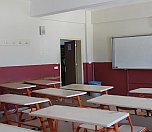Click to read the article in Turkish
February 6 earthquakes caused significant devastation in the southern part of Turkey, affecting 11 provinces with 21 percent of the country's students and 19 percent of teachers affected.
The Education and Science Workers Union (Eğitim İş) conducted visits to the earthquake-stricken areas during the first week of the new academic year to assess the realities and problems in the region, resulting in the preparation of a report.
Damaged Schools
According to the union's report, a total of 775 schools were either destroyed or suffered severe damage due to the earthquake, 205 in Adıyaman, 170 in Hatay, 100 in Urfa, 95 in Maraş, 70 in Malatya, 32 in Kİlis, 31 in Osmaniye 6 in Diyarbakır and 5 in Adana.
However, it's worth noting that the report from the Strategy and Budget Directorate of the Presidency states this number as 576, approximately 200 less than Eğitim-İş has identified.
Tents Set Up in the Yards of Damaged Schools
The report also reveals that approximately 775 unusable schools were completely evacuated and relocated to different institutions. Consequently, nearly twice as many schools had to switch to double-shift education. Some damaged schools have set up tents and container classrooms in their yards to continue education. According to Eğitim İş, the already inadequate physical facilities have evolved into conditions unsuitable for education.
Despite the presence of damaged and evacuated structures in some schools, education continues in sound buildings on the same premises. The lack of adequate safety measures in these institutions poses a serious risk in the event of another earthquake.
Higher Education Institutions
One out of every five university students in the region was exposed to the earthquake. Nine buildings belonging to universities in the region were completely destroyed. Among the 16 universities in the earthquake-affected area, a total of 111 buildings suffered severe damage, and 50 buildings sustained moderate damage.
Education Workers
The earthquake resulted in the loss of 931 education workers' lives. Many education workers in the region, especially those living in Hatay, Maraş, Adıyaman, Malatya, and the districts of Nurdağı and İslahiye in Antep, have seen their homes become uninhabitable, and some have lost their loved ones. While containers were allocated to education workers whose homes were severely damaged or destroyed, newly appointed teachers do not have housing options.
Students and Parents
The report indicates that approximately 4.1 million students and their families affected by the earthquake are experiencing trauma and stress disorders. Children who found it challenging to return to their normal lives either because they felt safer at home or didn't want to be separated from their families have skipped school for an extended period.
Many students who experienced the earthquake couldn't continue attending the same school, particularly in heavily affected areas. The orientation efforts for students transferred to other schools due to earthquake damage were insufficient. Transportation problems have also led to increased absenteeism.
According to the report, the motivation for both parents and students to engage in education is low, and the guidance services provided at schools are inadequate.
The union has put forth several demands, including:
* Scientifically identifying teacher shortages in the region and appointing teachers who haven't been assigned through initial appointments to address the shortage.
* Extending earthquake compensation payments to 3 years and setting a minimum of 10,000 lira.
Increasing service points by 100% for those working in earthquake zones.
* Organizing rehabilitation-oriented camps or holiday programs for education workers who lost their homes or loved ones.
* Granting unconditional transfer rights to education workers currently working in the earthquake-affected region or those who wish to come to the region.
* Promptly identifying and addressing physical deficiencies in schools through material and equipment distribution by the Ministry.
* Providing aid, such as tablets or computers, to students who have lost their homes.
February 6 earthquakes
On February 6, two earthquakes with a magnitude of 7.7 and 7.6 struck the southern city of Maraş. The first quake in the Pazarcık district at 4.17 a.m. was followed by the second one in Elbistan about nine hours later.
The quakes affected 11 cities in Türkiye's south and southeast, as well as Syria's northern parts, where over 5,000 people have died.
Türkiye's death toll from the quakes stands at over 50 thousand and is expected to increase further, as over 160,000 buildings were destroyed or severely damaged, according to government figures.
Nearly two million people have been displaced due to the earthquakes. (RT/PE)





